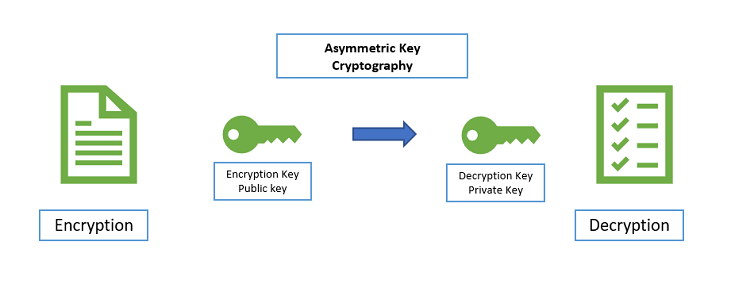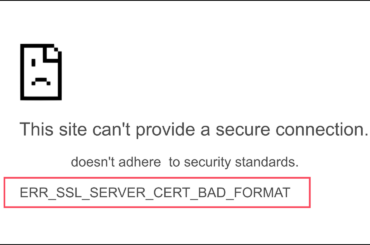Learn what asymmetric encryption is, how it works, and what it does
When it comes to the word ‘Encryption,’ we think of it as a technique that protects data using a cryptographic key, and there’s nothing wrong with this. However, what most people don’t realize is that there are different types of encryption methods. Asymmetric Encryption, also known as Public-Key Cryptography, is an example of one type.
Unlike “normal” (symmetric) encryption, Asymmetric Encryption encrypts and decrypts the data using two separate yet mathematically connected cryptographic keys. These keys are known as a ‘Public Key’ and a ‘Private Key.’ Together, they’re called a ‘Public and Private Key Pair.’
Let’s see how these two keys work together to create the formidable force that is Asymmetric Encryption.
How does Asymmetric Encryption work?
Asymmetric Encryption uses two distinct, yet related keys. One key, the Public Key, is used for encryption and the other, the Private Key, is for decryption. As implied in the name, the Private Key is intended to be private so that only the authenticated recipient can decrypt the message.
Let’s understand this with a simple asymmetric encryption example.
Pretend you’re a spy agency and you need to devise a mechanism for your agents to report in securely. You don’t need two-way communication, they have their orders, you just need regular detailed reports coming in from them. Asymmetric encryption would allow you to create public keys for the agents to encrypt their information and a private key back at headquarters that is the only way to decrypt it all. This provides an impenetrable form of one-way communication.

How are the two keys generated?
At the heart of Asymmetric Encryption lies a cryptographic algorithm. This algorithm uses a key generation protocol (a kind of mathematical function) to generate a key pair. Both the keys are mathematically connected with each other. This relationship between the keys differs from one algorithm to another.
The algorithm is basically a combination of two functions – encryption function and decryption function. To state the obvious, the encryption function encrypts the data and decryption function decrypts it.
This is how Asymmetric Encryption is used in SSL/TLS certificates
In SSL/TLS and other digital certificates, both methods – Symmetric and Asymmetric – are employed. Now, you might be wondering, ‘Why both? Shouldn’t Asymmetric cryptography be used as it’s more secure?’ Granted, it is more secure, but it comes with a pitfall. A major drawback when it comes to Public Key Cryptography is the computational time. As the verification and functions are applied from both the sides, it slows down the process significantly. That’s where Symmetric Encryption comes and saves the day.
First, when two parties (browser and server in the case of SSL) come across each other, they validate each other’s private and public key through Asymmetric Encryption. Once the verification is successful and both know whom they’re talking to, the encryption of the data starts – through Symmetric Encryption. Thereby saving significant time and serving the purposes of confidentiality and data-protection. This entire process is called an SSL/TLS handshake. If you want to learn more about this handshake, here’s an excellent post for you.
Difference between Symmetric and Asymmetric Encryption
| Symmetric Encryption | Asymmetric Encryption |
| Symmetric encryption consists of one of key for encryption and decryption. | Asymmetric Encryption consists of two cryptographic keys known as Public Key and Private Key. |
| Symmetric Encryption is a lot quicker compared to the Asymmetric method. | As Asymmetric Encryption incorporates two separate keys, the process is slowed down considerably. |
| RC4 | RSA |
| AES | Diffie-Hellman |
| DES | ECC |
| 3DES | El Gamal |
| QUAD | DSA |
You’re using Asymmetric Encryption without even realizing it
When you visit any HTTPS website/webpage, your browser establishes Asymmetrically encrypted connection with that website. Your browser automatically derives the public key of the SSL/TLS certificate installed on the website (that’s why it’s called ‘Public Key’). Do you want to see what it looks like? Click the green padlock you see in front of our URL, and go to certificate details. This is how it’ll look like:
30 82 01 0a 02 82 01 01 00 c2 d8 be ec a4 e1 52 20 7f 7f 7d 1a 17 38 99 17 ef 6a 9e af 66 89 67 5a 58 e2 b8 7c 76 f2 b8 c6 8f 98 e4 06 eb 3c 1c 04 34 1e 10 a9 42 c2 34 be 99 3b 98 7b 35 60 3a d5 41 bb 96 19 1a 3c 66 a0 75 77 64 2a 2e 19 42 5a b1 d0 1f 4d ac 32 2e af 4e 20 b8 89 07 83 51 21 e4 35 02 4b 10 45 03 37 ce 26 87 e0 b8 4d dc ba c5 e7 ae 60 68 b3 0c a3 5c 4f dd 30 1f 95 96 a5 2e e5 6f ae e8 e2 dc df 3a ab 51 74 82 f5 9e 15 3a ab 7c 99 3c 07 5b ad f2 88 a2 23 1c cd 41 d8 66 a4 90 0d 4a 23 05 5c de aa e3 82 13 f4 08 87 b3 34 08 6f 38 fb f8 84 ec 06 99 e0 ab 8a ab 1b 7c 99 fd 57 94 67 17 15 b7 27 67 c1 bc d1 a7 f6 c6 7e 01 63 02 0c 03 c4 bb 1f 70 0d db 27 ab 79 57 d9 92 35 f3 92 3c ad f4 fb f0 36 82 33 5a a0 f9 82 78 04 a6 e7 d6 ee 01 23 68 36 68 3b 41 fe 68 56 0b 6b 36 3b 83 b1 02 03 01 00 01
Amazing isn’t it?
So, this key encrypts any information you send to our website during the initial handshake, and our Private Key will decrypt it. Do you want to see what our Private Key looks like? Here it is:

Oh wait, that’s the key to our office. Did we tell you that the Private Key is supposed to be “Private?” Yes, you should NEVER EVER give it to anyone and keep it close to your chest (not literally). We recommend storing it at a location where only authorized people have access to it. If possible, you should try and save it on a hardware device that’s not connected to your system all the time.
Asymmetric Encryption Example
The most well-known example of Asymmetric Encryption is the Digital Signature Algorithm (DSA). Developed by National Institute of Standards and Technology (NIST) in 1991, DSA is used for digital signature and its verification. DSA is an example of asymmetric encryption based on modular exponentiation and discrete logarithm.
Concluding Words About Asymmetric Cryptography
Still here? Good. We believe that now you (hopefully) know what Asymmetric Encryption is and how it protects you from the wrath of cybercriminals. If you have a website and want to protect it with the same technology.
Related Resources
- Decoded: Examples of How Hashing Algorithms Work
- Explained: Hashing vs. Encryption vs. Encoding
- 5 Key Takeaways from Google HTTPS Encryption Transparency Report
- What is SSL Certificate Chain – Explained by Certificate Authority
- What is a Standard SSL Certificate? Compare Features & Prices
- How to Get Rid of ERR_SSL_PROTOCOL_ERROR in Google Chrome Browser
- How to Fix NET::ERR_CERT_COMMON_NAME_INVALID
- How to Secure a Website with VeriSign SSL Certificates





